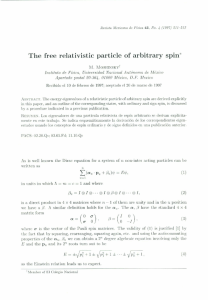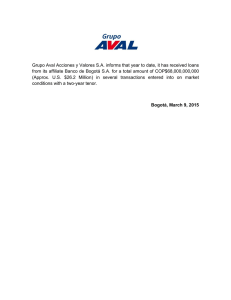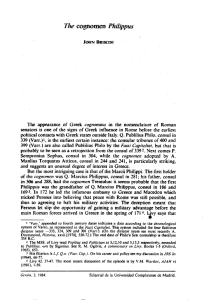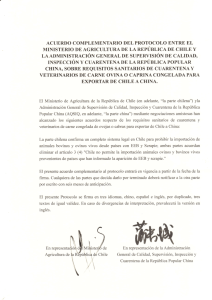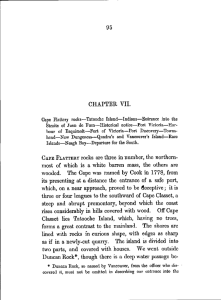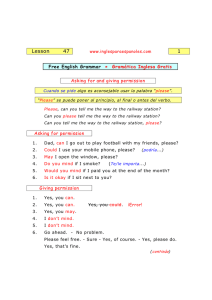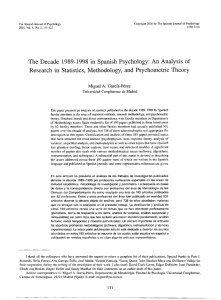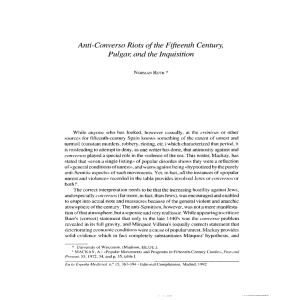CHAPTER IX INLAND COMMtJNICATION AND TR.\NSPORT ONE
Anuncio
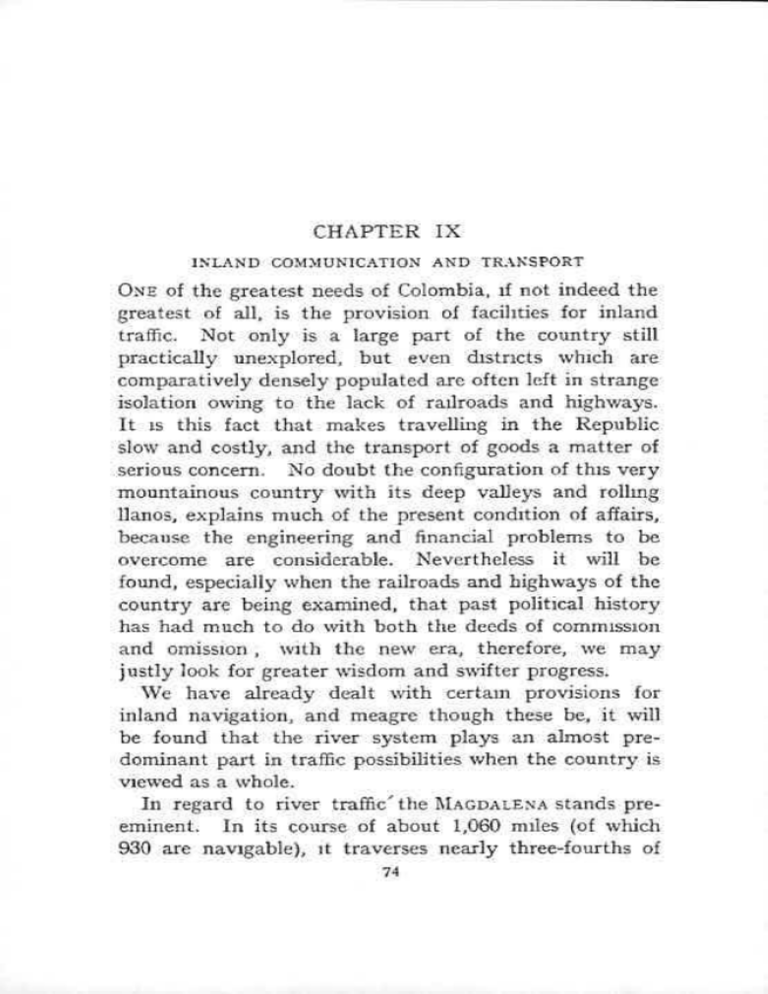
CHAPTER IX INLAND COMMtJNICATION AND TR.\NSPORT ONE oí tbe grcatcst needs oí Colombia, if nol indeed Ihe greatest nf alt, is tite provision oí facilities for inland traílle. Not only is a large part oí the country still practcally unexplored, but even dtstncts whLch are comparatively, densely populaed are oftcn left in strange isolation owing to the lack oí railroads and highways. It is this fact that makes traveUing in the Republic slow and eostly, and the transpofl oí goods a malter oí scrious eoncern. No doubt the conñguration oí this very mountainous country with its deep valleys and rolluig llanos, explains much oí the present condition oí affairs, hecanse thc engineering and financial problems to be overcome are considerable. Nevertheless it vil1 be found, especially, whcn the railroads and bighways oí the country are being examined, that past political history has had much to do with both tite deeds oí commission and omissiori with the new era, thercfore, WC may justly ook for greater wisdorn and swifter progress. Vc hayo already dealt vith certain provisions for inland navigation, and meagre though these be, it vill be found diaL the river system p1ays an almost predominant part in traffic possibilities when the country is viewed as a whole. Tu regard Lo river traffic' flie MAGDALENA stands pre. eminent. In its course oí about 1,060 miles (oí wldcli 930 are navigable), it traverses near]y threc-fourths oí 74 r ¿ ¡ 7. r COMM UNTCATJON AND TRANSPORT 75 tite central pan oí the Republic, and bv mcans oí as tribularies taps rrian' ni the most thickl y ponulated of tite agricultural aud industrial regions Unfortunately, although the fourth largest nver in South Arnerica, it partakes fur long 5tretches tire character oí a mountain stream Rroadly speaking, the river is navigable ínr' larg e steamers froni thc Atlantic aLmost np tu Florida, Í1 distance oí about 1,000 kitomtr ps for small steamers Irozn aboy e Honda tú Neiva for hoats and raíts ap tú the confluence of tite Paez. As a maiter oí fact, however, ihere are numeroas obstacies tu be met with. Much dredging ami rectification oí hanks are required in dic lower reaches before large steamers can enjoy a free and casy course aH the ycar round Real difflculties begin al Honda, just aboye which are the celebrated Fali and Rapids oí that name. These canse most oí the steamers tu anchor a shori distancc below tite pon. For up-country traffic this stoppage generallv takes place ,u La Dorada, where there isa short railway running to Honda and then cm to Arnbalema By using this railway passengers avoid dic Falis of Honda and the narrow straits of Colombairna, where the river races beiween high rocky cliffs. At Ambalema passeiigers and goods once more join tite river, a short distance by small steamer being traversed before reaching Girardot,' where the railway to Bogotá begins. The steamers continue np tú Neiva, and then furthcr progrcss must be made by canoes, nr the peculiar raft-hoats known as Clzampans. On tite banks oí tite Magdalena are numerous pons, sorne little more than vharfs arid warehouses. The rivcr has also many tributaries. Soun afta leavirtg 76 COLOMBIA Barranquilla oit the south bank is Calamar, the river port and railhead oí the Cartagena railway. Just aboye, oit tite north bank, is Heredia, an important collecting depot oí the rich agricultura[ Magdalena plains. Higher up, oit the south bank, is the mouth of the Cauca. A regular service of steamers ply up (he river from Barranquilla Lo Valdivia; alzo up a tributary oí the Cauca, the Nechi, as far as Zaragoza. The Cauca is tased on many 'oí its stretches by both steamers and rafts, assisting in traffic between such towns as Cali and Cartago, but the bed is ¡it marty parts impassable owing to falis and rocks. Returning to the Magdalena sve fluid on its noflhi bank the river cesar, which aflords a watenvay through fertile regions (o (he Valle Dupar and (he Goajira Peninsu.la. Here is alzo tite mouth oí tite partly navigable Lebrija, which runs south-east, steamers going as far as Estación Santander, chan;frans continuing the voyage (o Puerto Santos, where tite pack-mule trai] comrnences. Other tributaries use! tU as collecting and distributing channeis are the Opon and Carare, opening up the country cf Santander; the Sogamoso, tapping Santander and Boyacá and thc Nare, travcrsing part oí Antioquia. To return once more to (he main stream oí (he Magdalena, Jesus del Rio and Zambrano are important as the coifee and tobacco depots oí Bolivar;oíMagangué is the gateway Lo the cattle-raising plains Coroza]. From Puerto Wilches a railway is under construction to Bucaramanga, which district is also served b y La Gloria, Bodega de Carmen, and Bodega del Sur. Froat Puerto Berrio a railway runs south-west to La Quiebra and is being continued (o Medellin. COMMUNICATION AND TRANSPORT 77 It has already been said (hat tite navigation oí thc Magdalena is b y no means easy, this is due to sandbanks, rocks, and at certain seasons lack oí water. Conseqtiendy che service is apt te he slow and sornewhat irregular, moreover, jt is extrernely expensive owing to che frequcnt transhiprncnts In ms repon. te che Board of 'Frade, Mr. G. T. Mime says " \Vith a vjew to trnprovil1g conditions a canalisation tax is imposed en both exports and imports, the product being applied te the acquisition anci upkcep oí dredges." The work is carried out uncler 11w dírection oí the Minister oí Public \Vorks and a Canal;sation Board. According to a recent decree the tax is as foliows- Dollars &o)d per ter. On irnports of general nerchandise .. .. 4 5 On nat:oital rnnuiactu res Uj: corsunption . in thc country. .. 2 10 On nat:onal manufactures ter exportQn sa wn nr squn rt" d ti 1.1 x-r siip,a r, rubber rntnerals, lucios. ccffec. cucea artd s'ilt . . 1.60 061) Qn rhnber in ogs, and ñbres . . In 1912 this tax yielded about 117,000 dollars gold. un an impon cargo oí 41,500 tons and an expon cargo oí 53,300 tons. Mr. Mdne adds " \Vhi]e thc Canalisat ion Board probabl y does something to ixnprove navigation, to deal eíieetivel y with the problem (which is stated te be getting more serioits ever y year o\ving tu the dimirnshed amount of water in the rivers through deforestation) tcchnical advice oí the best kind available would be necessary, with presurnably 11w expenditure oí very large surus of money. At prcscnt canalisation works en an extensive sede rnight prove to be be ycad the country's resources, alchough a loan, secured en tite 78 COLOMBIA reveR tic derived frorn tie tax and expended by responsible foreign erigineers and contractors, might greatly improve existing eonditions. The first essential would be a thorough investigation oí the prob!em by a competent engineer. Ii bis report should be favourable lo expenditure a loan could presumably be arranged on condition thaI the collection oí the tax by the lending house tras satisiactorily provided for In -he event oí the necessary works being deemed beyond the country's resources, the only solution oí the difñcnity would seem to he br the Gover-nment to assist such railway enterprises as wou]d tend lo facilitate communication betwcen the littoraj and the interior. Eventually a trunk une, linking up existing and projected railways, ma)' cross thc country from ocean to ocean; but it scems improbable that a work oí Ihis magnitude will be undertaken in the near future." Before discussing Ibis and other aspects of the radway problern we must say a kw words about the steamboat accommodation in the Magdalena, and also on the other navigable waterway systems of the Republic. That such facilities as the Magdalena offers should largely monopolise attention is explained when WC realise thaI elose upon SO per ccnt. of tite value oí imports, and over 60 per cent. oí the exports pass through the Customs of Barranquilla and Cartagena, and as on]y a small proportion oí these gonds remain in the two eities, or are distributed in their neighhourhoods by rail or carts, or transhipped to Santa Marta, it is clear what a preponderating part this river plavs in the business life oí the country. While tliere is a fair arnount oí competition in the provision oí stearnboat service, the two teading COMMUNTCATJON AND TRANSPORT 79 organisatlons are a local corupany, thc Empresa Hanseatica, anci an English cornpanv, the Empresa Aijadas, both of which are managed by Colombian fu-ms. The Hanseatica has a flect oí seven steamers oí 1,269 tons in aH. aud the Aliadas twenty-nine steamers oí over 6,000 tons. These steamers, and tbnse oí ther owners, are r. drawing little water and flat-bottorned sterr.designed on the Unes oí tite American nver steamboats. A weekly exprcss mail service to Bogotá, and iiiterniediate services, are tun b y tite Aliadas for a monhly Govern:nent subsidy oí £1.000. Passenger rates and cargo freights are on a taníf approved by the Government, rebates being aUowed oit certain classes oí goods. Thus tite charge kw carriage oí general merchandise from Puerto Colombia to La Dorado, thence over rail to Arranca Plumas, thcn by river, and again by rail to Bogotá k about £12 per ton, caiculated thus ¡it goid dollars per tonRa u Ivay- tr',uh t - Puerto Coloni hia to Barrancpulla -. Ruverfriglit. Bru-ranqudb lo La Dorado Sundrv charges Man:ícst and Starnps - Loadmg nw-r steanii -- CM,t1 isat ¡ori La x - - - - Cus:oms dcspa:ch - - - Cartage - - - Cornniissio:i - - - - Through ircight, La Dor3do-r3ogoá -- 263 140 1 60 60 '20 20 10 1 20 25 :33 58i38 The through rates from Cartagena are thc sanie. It should he noted that there is a rebate oí 23 per ceiit. on the nver freights for agricultural and mining machinery, 80 COLOMBIA tcols and wire netting, and 50 per cent. on railway material. Mention has already been made oí the CAUCA, which taps part oí Bolivar, Antioquia, Caldas, El Valle asid Cauca. It is navigable frorn the Magdalena, near Magangué, to Rio Nuevo but tbence tú the city oí Antioquía the river is irnpassable. Abo ye that thcre is a considerable reach oí fair waterway, a busy traffic bcing kept up from a little abo ye Cali and rather beyond Cartago. The Neehi and ather tributaries bring addi. tional traffic to this river, giving access to districts lying eastward. Dic SINU, draining the low-Iying cattle aud sugar plantation lands oí western Bolivar, is open to steamers from the Gulf oí Cispata to Monteria. Going west, there is thc Atrato, failing hito the GUJf oí Darien and navigable as far as Quibdo. Plans have been prepared for a short canal from Cupica Bay, by which this river would be given an outiet into the Pacific. Whule the eastern siopes oí the Cordillera and wide vallcy oí the dcpartment oí El Valle is served by the Cauca, the western slopc and coastal forcst rcgions are served by the San Juan, which is open for steamers froni Buenaventura to San Pablo, and for small boats to Dipurdu. There is a project to join the San Juan with the Atrato by canalisation, which would also have the effcct oí giving direct water comrnunication between the Atlantic and the Pacific. But the engincering difficuRies are very considerable and tIte probable cost, in view oí the class of possible traffic, appears prohibitive. The PAT ¡A di-ains the son th-western border oí Cauca COMMUNJCATION AND TRANSI'ORT 81 and the western part oí Nariño, ílowing into (he Paciñc not lar from the Ecuadorian frontier. On ihe casteru side, dic META rising rn thc Cerro del Nevado (w)ierc snow-cappcd peaks, 14,110 U. aboye sea-level, leed enotmous glaciers), lying to dic south-west of Bogotá, skirts the foot-hilis oí thc Eastern Cordillera, and, flowing through ihe great territory oí Meta and the southcrn border oí fue Comisaria oí Arauca, which is tapped hy tributaries, joiiis the Orinoco at (lic Venezucian frontier, aud affords an outict into fue Atiantie through Lake Maracaibo. The GU:\VIARE river riseb on the southern siope oí tite Cerro del Nevado, and just be!ow Uribe is joined by thc Ariari, which res in tite foot-hilis oí the Cordillera de SunTapaz and passes by the town oí Arana. The Guaviare continuing ;vitli a north-eastward trend, cuts the Meta terrizory alrnost in two and fiows into ihe Orinoco. One da>' it may become o í great importance. The Yupura, which itows right through thc Caqueta territorv, tapping it right and left by mcans of many tributaries, and fue Putumayo, south oí the Caqueta, both oí which flow into the Marañon, are watenvavs whose usefulness are bound to be largcly developed in dic near future. Othcr ruvers are navugable, though the y are generaily, tributaries oí the systems already mentioned. Sorne partxcuiars oí thcse vi1] be found in dic chapter on Pons and Ilarbours. RAILwAYS.—T'or the mornent the railways oí Colombia present an cxtraordinary absence oí systematio dcvclopment. There are fourtecn unes, ranging from 15 to 55 82 COLOMBIA miles in Iength, dotted about the country, few having art)' direci connection witit any other. This seemingly haphazard scatteriug of short stretches of railways in isolated districts is to a considerable extcnt the result of tite oid Sovereign State regime, wheri theta were seven nr eight Governments each ambitious to enter into tite civilised world's race for raúway construction, but without much regard to what their neighbours were doing, or to tite needs of the Coníederation as a wholc. Twa of the ohviousiy neccssary unes are those of tite Barranquilla anci the Cartagena railways, both owned by Fnglish conipanies. The lirsi is 15 miles long and links up Puerto Colombia with Barranquilla, and has a capital (in shares and bonds) of £300.000 The second runs between Cartagena and Calamar on the Magdalena, a distance of 65 miles; it has a capital of £1,350,000. ]'he Barranquilla railway carnes foar times as many passengers aud raiher over twice as many goods as the Cartagena li'ne. Both perforrn a useful purpose, yet they entati art expensive system of transhiprnent. Santa Varia Railway. Santa Marta, whose port is regularly visited by the Elders-Fife Ene as well as the ships oí the United Fruit Company and the Hamburg American une, is the starting-point of a railway, owned by tite English Santa Marta Railvay Company, Ltd. (capital, sitares and bond, ¿506,370), svhicli runs to Cienega on tite river Fundación. It has 72 miles of track, and is moreover fed by about 10 miles of short private unes serving banana piantation estatcs. There is a project to carry tite une to Banco art the Magdalena, near to its confluence with the Cesar. This would add about 135 miles to the Une. COMMUNICATION AYD FRANSPORT SS On the Paciflc wast thc Cauca railway, ts'hicli vas staricd forty years ago and has Md a chequered carcer, is 110W lii tite hands oí a Local coznpany, dic Compania del Ferrocarril del Pacifico, It has a paid-up share capital of 354,000 doilars goid, and a bonded debi lloated in London of LI 19,200 lis Inc runs (ram Buenaventura towards Cali, which it has ncarly reached, about 83 ¡rules being open and in operation. Hari<ing back tn the Magdalena, at a point known as Puerto \Vilches ve find dic Crea! Central Norl/:ern Raiiway Conpany. Lid (art Enghsh concern witit a share and o bond capital oí L1,001.760 , the Governntent í Colombia holding £50,000 (.f sitares), constructing a ¡inc tu Bucaramanga, of whicli over 12 miles are completad. This company, secured tite right to prolong its une f ron Bucaramanga, so as lo form a junction with the Ferrocarril del Norte. Higher np thc river, un tiLe wast bank, is busy Puerto Berrio, wiiere conimences (he A ntzoquia Razlway (which is owned 1w thc departmcnt). It is new ncarly conpicted as far as Mcdellin, a dtstance oí 120 miles. Practically art extension oí this ratiway is being run from Medeihn through Amaga tu thc Cauca river. TILIS extensiun new reaches Caldas, 19 miles distant, and sttil has te be carried another 23 miles. Mr. Mime states that freights oit Ibis railway, (ron Puerto Domo tu Cisneros (109 kioms.) are 20 cents goid en general ¡nerchandise, 15 cents Oil coflon yarn, petrolcuni, iour and salt, and 15 ccnts on machinery, galvanised tren, wire icncing and steel, aH per ton-kilornetre. Sorne distance farthcr np un tite west bank, jusi below 84 COLOMBIA Honda, commcnces tite La Dorada Radway, owned by the Dorada Extension Railway, Ltd., with a capital oí Ç7OO.000. As elsewherc atrcady explained, thrce o í its stations, La Dorada, Honda and Arranca Plumas are on the Magdalena, and Ihere is an extension to Ambalema. Its chief reason Sor existence is to act as a portage, calTying all passengers and goods traflic between La Dorada and Ambalema, thus avoidng the impass.able rapids about Honda. It also receives much trafflc from Manizales and elsewhere, which comes over (he Quindio pass road. Ile main, or river skirtiiig lino, is 31 miles long, aud the extension 51. StiU higher np, at Girardot, comrnences a narrow gauge ratiway, owned b y tite English Colombian Nationci Railway Company, Ltd. (capital £900,000, one-third owned by the Government, and a bonded debt oí £1.480.000). The 82 miles oí the Colombiano National Railway end at Facatativa, whence another radway oí 24 miles starts for Bogotá across the platean. It caries over 70 por cent. oí traifie to ¡md frorn ihe Sabana oí Bogotá, though np te 1913 ¡note than haif oí the total found its way down to the valle y bv 'ay oí the Honda mule track and the Camboa cart road (Bogotá itself centre oí faur railways serving the Cundinamarca platean. Besides the Girardo! ¡inc there is /hc Sabana (practically owncd b y (he Government), which has 25 miles out, te Facatativa. The Ferrocarril del Norte, owned by thc English Colombian Northern Company, Lid. (capital, shares and bonds, £780,000) has a 29 miJe une to Zipaquira. It has ¡nade over its cancession COMMUNJCATION AND TRANSPORT 85 br (he construction oí an extcnsion ¡toro termmus to Chiquinquira, where it would conncct up witli an extension from Bucaramanga, tu the Colombian Central Railway Company, a short brandi (9 miles) connecting Zipaquira and Nemocon. The Ferrocarril dd Sur, the property of the Governrnent, runs from Bogotá tu Sibaté, a dístance oí 19 miles. It is proposed ultiniately tu link np Girardot with Ibagué, in Tolima. Work has already been commericed on this Tolima Railway, which is the propeny oí the Govet-nment, from the Ibagué end, about 15 miles being in working order. North-east oí Bucaramanga. in Norte de Santander, is the go-abead town oí Cucuta. In 1888 lis merchants, with the assistance oí the Nunicipality which owns a third sitare, constructed a railway 37 miles long to Puerto Viflamizar, on the Zulia river subsequently an cxtenson of 10 miles wa.s made to the Venezuelan frontier, joining the town of Chiguara. Such is the railway position to-day. The Government is credited with projects to link np (hese VariouS isolated unes. The Buenaventura lisie (o Cali woulcl be carried norib, passing through various towos, to join the CaucaMeddllin lino and so through to Puerto Berrio. Thence it would turn south to join ,he Dorada lino, whcrc a branch wou.ld tun tu Tocairna un the Girardot une, thus !inking up with Bogotá. From Bogotá tite Norte is to be prolonged te Chiquinquira, forming a conjunetion with the Bucaramanga lino to Puerto Wilches. A une across the Quindio would connect Cartago wfth Girardot, and a branch une from Medellin would run to the Guil oí Uraha. A branch would run- from Girardot te La 7L'45' 86 COLOMBIA Plata, while the Buenaventura ratlway would be tun south through Popaan and Pasto tú the Ecuadorian frontier. To complete the network, a branch vould be buiD from Bucaramanga tú Cucuta. Thus only the tinte Atlantic unes would be leí , unconnected. A free hand has been reserved b y the Government in the matter oí railwa y construction .Alaw passod in 1892 gives power to the Executive tu grant concessions without rcference lo the Legislature Subsidies inay be granted in the form of not ¡note than 300 hectars oí public lands, plus a sum not exceeding 10,000 dollars goid, payable in 6 per cent. amonisable bonds, per kilometre ()Cfl tú traflic or a guarantee for not more than twenty ycars oí intcrest not exceeding 7 per cent. on capital actuallv invested, and not exceeding 30,000 doilaN goid per kilometre open to traíñe. This guarantee ceases if and when the railway succecds earning in three consecutive vears a profit suffmient to pay the guaranteed interest A concession may be given for as long as 100 years. As a rule, the Goveniment reserves power to purchase the railway at any time after fift' years on valuation, and aiter sevcnty-fLveyears on payment of 50 per cent. of actual value It will be readily gathered from what has heen said aboye that when all allowanccs have been made mr river trafflc and railway service, the com:nerce oí the country as a whole is still chiefly dependerit mi ordinary land transport. \Vhile in a kw districts, mainly in the imrnediate neighbourhood of a few oí tite b2g cines, there are gc'od liigh-roads, availabk for public amI private motor traffic, ami a rather larger mileage open to heavily bui]t carts, mosi places are only accessible for foot COMMUNICATION AND TRANSPORT 87 passengers. pack-horse-s and mules, over more or less well defined tracks. Ro.kus —0n the Sabana of Bogotá sorne cxcellent highwavs are lo be found The niost notable of thesc is the Carretera Central del Norte, which unites Bogotá te Santa Rosa in Boyacá It passes througli ihe rnuncipa1ities of Usaquen, Cha, Cajica, Sopo, Tocancipa. Gachancipa, Nemocon, Suesca, Choconta, Villa Pinzon, Boyacá and Santa Rosa, a distance of 200 miles, and is traversable 1w carriages ami motors. Next in importance is the'Carretera de Cambao, uniting Bogotá with Cambao sorne 130 miles away mi tite Magdalena. These are supplementcd by a nurnber of smaller roads arid bridle paths. In Antoquia the gcod caft roads also radiate from the capital. There is Fue Nort!t Eastern toad tu Santo Domingo, Uit southern lo Caldas, and others to Envigado and La Quiebra. Iii Atlantico the onl y carl road is that betweervl3arranquilla and Usiacuri, about 30 miles long. In Bolivar tlicre are projects for highways umting Barranquilla wmth Calamar and Turbaco, and another between Monteria arid Magangué. In Boyacá fairl y good brandi roads from 11w grcat Ncnh Road unite Quctame vitli Sogamoso ami so with the Magdalena, Ibe other running out to Catare. Over a rnile of tkie new road to imite Saniaca, Sachica ami Chiquinquira, has been constructed In El Valle a road oí sorne 40 miles unites Buga ami Palmira In Norte de Santander the Carretera Central del Norte is under construction, and is making slow progrcss. In Santander the only cart road is between Bucaramanga and Florida, a distanc.e of about 15 múes It is not a long list. 88 COLOMBIA Apart fron these are severa¡ vel1-known and muck frequented tracks, sorne traversed by horses and muies, others only possible for foot passcngers. The most famous of these is the Quindio road, which may be entered from Girardot on the Magdalena, touching att Ibagué and then over rhe Central Cordillera by the Quindio Pass luto the Cauca vaUcy to Cartago. Another ancient and much frequented road is that from'Neiva oit the Magdalena, across the paramos of Guanacas and Cocortucos on the Central Cordillera to Popoyan. A track is being made between Quibdo, capital of tite Choco territory, to Bolivar. Many of rhesc tracks are difhcu!t att tite hest of times, and even the good ones are of ten impassable in the rainy seasori. Males are prefe.rred tu horses, as heing hardier and more sure-footed. Por pack mities a load, or cargo, is lirnited to twa packs of from 60 to 70 kilogs. each, according tú tite mute tu he traversed, and br hght bat baiky ioads 300 cubic decirnetres is the iirnit. Por the more difficult tracks and passes smaller and lighter packs are necessary as they tiave to be carried un men's or women's backs. un all districis mide and carrier contractors will he found, with thcir strings of wdi tramed beasts or human porten. Ti is ohvious thai for sucb transport as this careful packing is essential, not oniy as regards size and weight, bat the strength of dic cases or bales and ihe outer watcrproof covering. In the past very sericus mistakes have been made in connection with the sending out of heavy rnerchandise. While wondcrs han been done iii transporting machincry COMNUNICATION AND TRANSFORT 39 into the interior, for instance raiiway material Lo the Bogotá plateau before the days oí thc Girardot and cart roads, on the other hand it has of ten happened that expensive mining and milling machinery, sent out from Eu.rope, has had to be abandoned in the forest as being too buiky and heavy.
